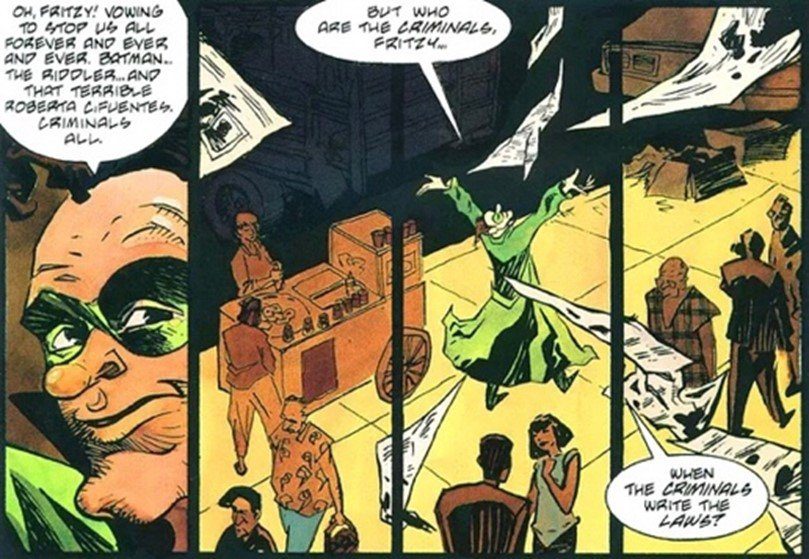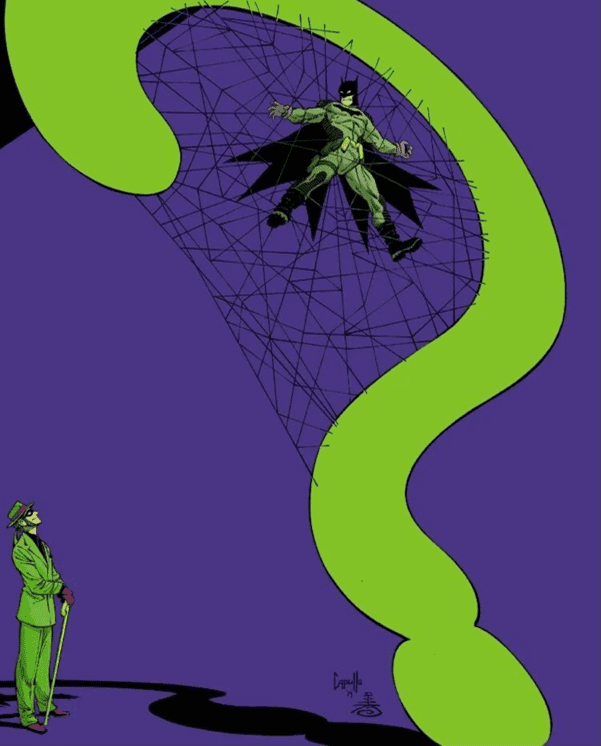He first appeared in 1948 in Detective Comics #140, where he was keen to prove his intelligence by matching his wits with the Dark Knight.
In The Batman, however, Paul Dano plays him as a calculated serial killer, leaving Zodiac-like clues and cyphers behind for Batman to find at the scenes of his crimes.
Going from challenging Batman and Robin via a giant crossword puzzle to murdering Gotham’s mayor with a carpet tool is certainly quite the leap to make. Yet, in many ways, this latest version of the Riddler is not such a far cry from his comic origins as you might expect.
In that spirit, here are some recommendations for all you Riddlefans who want to delve a little deeper into the history of Gotham’s Prince of Puzzlers.
The Riddle Factory
The Riddler starts up an illegal game show, which is just as wacky as it sounds. Broadcast nightly to all of Gotham, it’s a mixture of surface whimsy and horrifying audience participation, as members of the public willingly enter death traps that only the correct answer to a riddle will see them released from.
That’s not the kicker, though. The answer to each riddle, when pieced together, leads to a member of Gotham’s elite having their deepest, darkest secrets exposed during the show’s finale. Each reputation ruined is usually followed by fatal consequences too. Though — just like in The Batman — you won’t always find yourself feeling too sorry for some of the victims of the Riddler’s revelations.
This comic was published as a tie-in to the 1995 film Batman Forever. Curiously, though, the character on the page bares little resemblance to Jim Carey’s manic prankster version of the Riddler as seen on screen — a portrayal that famously and hilariously resulted in Tommy Lee Jones telling Carey, “I cannot sanction your buffoonery” during filming.
It’s also been cited as a favourite and an influence by Cory Michael Smith, who played the Riddler for five years on FOX’s Gotham. It’s well worth checking out for that reason and that alone!
Batman: Run, Riddler, Run
A bit like this tale’s title character, Run, Riddler, Run is an odd-ball of a story. Rampantly political, with an artistic style that frequently takes abstract to the point of grotesquery, and a naïve Batman.
On the face of it, there’s a lot there that could put off a potential reader. Nevertheless, it grows on you, and not least because of the Riddler. His role as a wildcard, yo-yo-ing between sides as he sees fit, is a very befitting one for the character.
The plot largely centres around the conflict between the “New Gotham” project, which aims to build a crime-free enclave within Gotham, and the poor inhabitants of the neighbourhood that’s going to be demolished who are set to be cleared out to make way.
Batman, after being given a close-up look at what it’s like to be criminalised for being poor, steps in to protect the inhabitants’ leader Roberta Cifuentes from the “New Gotham” private security forces, who have rather unwisely been given police powers by the mayor. As a result, he is swiftly framed for murder and forced to go into hiding.
The Riddler, meanwhile, recently released from Arkham, abandons his job as a security consultant on the “New Gotham” project in favour of teaming up with Batman to take down the corrupt elements at the project’s heart.
This story is probably the most concrete example of a politically motivated Riddler railing against establishment corruption, as he does in The Batman. In the comics, his usual modus operandi is to steal whatever happens to have caught his eye. Ultimately, though, he really seems to care in this story about the injustice of a system that would lump himself, Batman, and Roberta Cifuentes all into the same category.
Batman: Zero Year
In this reimagining of Batman’s early years for DC’s New 52 revamp, he goes up against a Riddler who’s always one step ahead and is playing a game of his own design that climaxes in the bombing of Gotham’s flood barriers at the exact moment a catastrophic storm hits, flooding the city. Sound familiar? Parts of The Batman’s third act genuinely feel like a direct page-to-screen adaptation at times.
After flooding the city, the Riddler takes control by holding its population hostage with a series of balloons filled with lethal chemicals. He then does a daily broadcast, with the promise that besting him with a riddle will see him free Gotham. It’s a war of minds that Batman eventually wins with a good punch to the face.
Questions Multiply the Mystery [Detective Comics Annual Vol. 1 #8]
Alone in an Arkham interrogation room, and annoyed at his psychiatrist’s ineptitude, the Riddler decides to recall the events in his life which have led him to this point. Moving away from the gimmickyness of the past, this story is a big checkpoint in the evolution of the character, as writers properly begin to sketch in some psychological insight.
Rapidly descending into mania as he relates his latest plot foiled by Batman, his emotional outbursts are revelatory, to say the least, and a reminder that his egotistical need for attention is as important a character trait as his mastermind intellect.
In this comic, the Riddler’s neglected childhood is put under the spotlight as it is in The Batman, too. Though not an orphan as he is in the film, he is still just as unwanted and overlooked. He’s so unremarkable, in fact, that he escapes being bullied at school by virtue of the bullies not noticing he exists.
This story also has what is personally my favourite — and one of the most memeable — comic panels of all time. Thankfully, The Batman produced a scene to match, with the Riddler’s histrionics upon discovering that his connection to Batman was a delusion of his own making being one of the film’s most memorable moments.
Batman: Earth One Vol. 2
As discussed here, there’s a lot of commonality between the Earth One trilogy and The Batman. In volume two, four corrupt city officials are in the Riddler’s crosshairs as he undertakes a bombing campaign, racking up no small amount of collateral damage along the way.
Similar to The Batman in tone and style, as well as in its vision of the Riddler as an anarchistic loner, what the film doesn’t draw from Zero Year it certainly gets from here. Grounded in reality as this graphic novel is, there’s also none of the character’s usual attention-grabbing antics to distract from the horrifying nature of his crimes, making him one of the most unsettling iterations yet.
What are your thoughts on this latest version of the Riddler? Are there any Riddler stories you’d recommend that weren’t included here? Let us know over on our social media channels.
By Louanne Weldon










